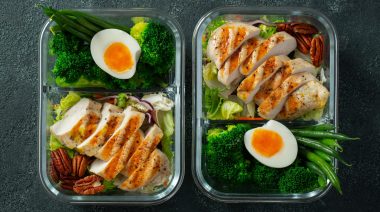When it comes to eating for your body, your health, and your goals, there’s a lot of talk out there about what you should and shouldn’t do. You’ve probably heard stuff like:
- You should eat 1200 calories each day if you want to lose weight.
- You should drink a protein shake after your workout.
- You shouldn’t eat more 50 grams of carbs per day.
- You shouldn’t combine fruit with any other food.
And on and on. Try as we may to put hard and fast rules around what you should and shouldn’t eat, there is no one-size-fits-all approach to what’s best for your body, your health, and your goals.
In recent years, there’s been a big push in the health and fitness world to count macros. Move over calorie-counting, there’s a new kid in town. There are “does it fit your macros?” programs popping up everywhere. All of them are intended to help you find the “just right” balance of proteins, carbs, and fats with your physical goals in mind (fat loss, muscle gain, performance, leaning out, boosting metabolism). While they all have great intentions, counting your macros (or calories for that matter), is just one piece of the larger puzzle of reaching your goals and improving your health.
Case Study: Sarah
Sarah was a 28 year-old coach and CrossFit athlete who came to me simply looking to optimize her own performance in the gym and for competition—especially with the upcoming CrossFit Open. She felt “pretty good” for the most part, except for occasional bloating and gas after meals. She also reported “hangry-ness,” with headaches and a little bit of shakiness if she went too long between meals.
Sarah put in long hours at the gym training and coaching clients. Most mornings she woke around 4:30am to teach class by 5am. By 7am she would hit her first training session of the day, and would spend an hour or two doing mobility, lifting weights, and maybe a short metabolic conditioning piece.
After training, Sarah would head home for a quick lunch, maybe take a 20-minute cat nap, and take care of some personal to-dos. Then she would head back to the gym to coach the 3pm and 4pm classes before hitting her evening training session—another hour or two of gymnastics skill work and conditioning. Then it was home for dinner around 8 pm and lights out by 9:30 or 10 pm (on a good day).
Over the past couple years, Sarah had discovered a macros-based approach to eating and meal timing when it was introduced to her by a coach, and she loved how it made fueling her body to support her training schedule fairly easy.
Here’s a what a typical day of eating entailed for Sarah:
Breakfast 1 (4:30 am)
- 2 ounces of leftover meat or 2 eggs
- ½ cup berries
- Coffee
Breakfast 2/Pre-training (8 am)
- 3 ounces of protein
- 1 cup veggies
- ¼ avocado
- Latte with almond milk
Lunch (12 pm)
- 3 oz chicken or ground turkey
- 1 cup of roasted sweet potato
- ½ avocado
Snack (4 pm)
- ½ protein bar
- Pre-workout powder
Post-workout (7: 30 pm)
- Protein recovery shake + carb powder
Dinner (8:30)
- 3 oz steak
- 1 cup veggies
- 1 cup of frozen berries
- 1 tablespoon coconut oil
Bedtime (9:30)
- Progenex Cocoon night time recovery protein
Wash. Rinse. Repeat.
On paper, she was following her macros, but as we explored how she was feeling during our initial intake session, she realized she wasn’t necessarily feeling at her “peak.” During our phone session, she reported not-so-healthy signs and symptoms, including dark circles around her eyes, a heavy reliance on coffee to get going most mornings, brittle fingernails, feeling bloated after drinking her whey protein, shakiness and headaches between meals, and a history of occasional gall-bladder attacks.
A lab test we ran revealed extremely high stress on her body (HPA-Axis Dysfunction), with an imbalance of cortisol, estrogen, and progesterone levels throughout the day. While her periods were “normalish” (every 28-36 days), her body’s internal balance was not. This impacted her ability to process and maximize her nutrient consumption. In addition, a SIBO test we ran (small intestinal bacterial overgrowth) revealed bacterial overgrowth in her upper GI, affecting her digestion and absorption of all her “good” nutrients.
She said she never really had stomach problems, but I explained that GI symptoms do not necessarily present as bloating, gas, or constipation. In fact, one in two people with diagnosed celiac disease never experienced symptoms like bloating, loose stools, or nausea to indicate that they had a gluten intolerance?
Sarah agreed she was willing to try a new approach to nutrition, despite her success with her current, macro-based approach. She agreed to give it 30 days with a “does it fit your body” approach as follows:
Pre-Breakfast
- 1 tablespoon apple cider vinegar in a glass of warm water
- 1 cup bone broth with grass-fed butter (1 spoonful), warmed and blended
- Herbal tea with L-Glutamine (while coaching at gym)
Supplements
- Probiotic
- HPA-Balance support supplement
- Glucose Regulation Guard supplement
- Zinc
- B-vitamin complex
- Cod-liver oil (1 teaspoon)
- Equi-Fem (female multi-vitamin)
Breakfast
- 2-3 chicken sausage patties
- ⅓ avocado
- Cold-pressed greens or sautéed spinach
- Handful berries, orange, or other fruit
Supplements
- Digestive enzymes
- SIBO supplement
- HCL tablet
- Gall-bladder support supplement
Lunch (Post-Session 1)
- 1-2 portions (fist sized) of chicken, bison, fish, or turkey
- 2 heaping handfuls greens (sauteéd in 1 tablespoon coconut oil or ghee)
- Sweet potato or other starchy veggies (about the size of a large fist)
- 1-2 spoonfuls coconut butter or butter, ½ avocado, olive oil/avocado oil
Supplements
- HPA-Balance support supplement
- Glucose Regulation Guard supplement
- Digestive enzymes
- SIBO supplement
- HCL tablet
- Gall-bladder support supplement
Snack
- Handful leftover protein
- Small handful nuts or ¼ avocado
or
- ½ Bulletproof collagen protein bar
Post-workout
- Beef Isolate recovery protein powder in water
- Optional: sweet potato powder (drink during hard training days)
Dinner
- 1-2 fist-sized portions of chicken, bison, fish or turkey
- 2 heaping handfuls greens (sauteéd in 1 tablespoon coconut oil or ghee)
- 1 sweet potato or other starchy vegetable
- 1-2 spoonfuls coconut butter or butter, ½ avocado, olive oil/avocado oil
Supplements
- Digestive enzymes
- SIBO supplement
- HCL tablet
- Gall-bladder support supplement
Pre-bed
- Herbal tea with L-Glutamine powder
- Magneisum supplement (topical oil)
Snack (optional)
- Coconut yogurt or full-fat grass-fed yogurt with cinnamon and vanilla extract
or
- 1 cup bone broth
Lifestyle Prescription
- Take 1-2 minutes to breathe before meals
- Chew your food really well
- Unplug from electronics at night after gym session
- Intentionally schedule a “you day”—outside of gym for play
As you can see, a little different than a “does it fit your macros” approach.
Four weeks later, we conducted a re-test assessment, and found significant improvements in her cortisol levels throughout the day, as well as a decrease in SIBO presence. She also reported significant increases in her energy levels and decreased “hangry-ness” throughout the day. As a bonus, she set a 10-pound PR on her backsquat and added five more pounds to an already impressive deadlift.
The Pros and Cons of Counting Macros
Let’s take a look at some straightforward pros and cons about counting macros.
Pros:
- Macros are a good starting place for someone who is completely in the dark about what to eat or how much to eat, especially if they have been significantly undereating (a common phenomenon, believe it or not).
- Macro-counting can give the nutrition newbie an idea of what a portion size can look like, and help incorporate balance at all meals (proteins, fats, carbs).
Cons:
- Similar to the calorie-counting approaches of the days of old, macro-counting can make you overly obsessed about food. Instead of seeing nourishment and joy, some people are only able to see 20g of protein, 30g of carbs, 10g of fat.
- Macro-counting very rarely takes food quality into consideration. There is a significant difference in the nutrients you get from a piece of chicken raised in a factory farm versus a pastured chicken breast grown on a humanely-raised farm; or a stick of celery every day with lunch, as opposed to dark leafy greens; or gummy bears versus strawberries.
Should You Track Your Macros?
Macro-based approaches are not just marketed to CrossFit athletes or fitness buffs. Whether you’re looking to gain weight, lose weight, tone it up, or “just eat healthy,” macros are definitely one method you’ll come across.
Just like as macros are marketed as simple and easy, the “does it fit your body?” approach is even easier and more simple. No weighing, measuring, or counting necessary. Your plan gives you a clear protocol of what your body needs right now, with the option to tweak and reassess along the way, as goals change and your health improves.
If you want to optimize your personal nutrition (and potentially save yourself some frustrating headaches as to why your macros only gets you so far), a “does it fit your body?” approach may be a better route for you to go.
More on nutrition that will work for you:






